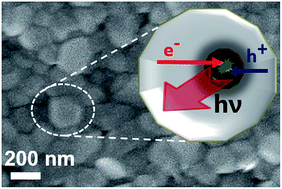Interplay of structural and compositional effects on carrier recombination in mixed-halide perovskites†
Abstract
In this work, we investigate the effects of grain structure and bromide content on charge transport in methylammonium lead iodide/bromide (MAPb(I1−xBrx)3) perovskites by examining the steady-state (ss-PL) and time-resolved (tr-PL) photoluminescence of planar films with varying grain size and bromide content. We controlled the perovskite grain structure via solvent engineering with N,N-dimethylformamide (DMF) or dimethyl sulfoxide : γ-butyrolactone (DMSO : GBL), and the resultant grain morphology was independent of Br doping between 0–33%. Carrier lifetimes ranged from 29–52 ns with increasing Br content for DMF-produced perovskite films, and from 2–9 ns for films obtained with DMSO : GBL. Analysis of XRD and photoluminescence data suggests this order-of-magnitude difference in lifetimes is attributable to the nature of iodide-rich recombination nuclei within the bulk perovskite. By modulating the precursor solvent and Br composition, the influence of low-bandgap recombination nuclei can be minimized to enhance charge transport and lengthen the carrier lifetime in mixed-halide perovskite films.


 Please wait while we load your content...
Please wait while we load your content...